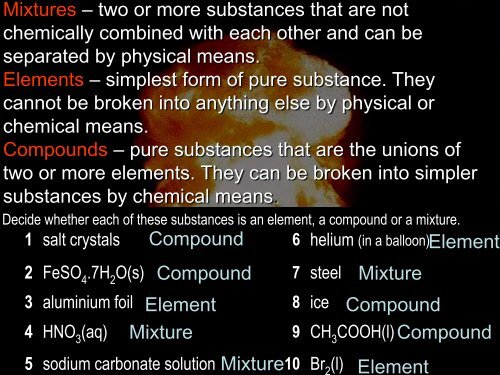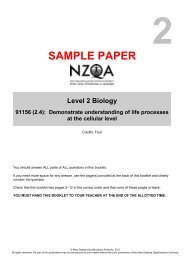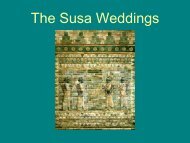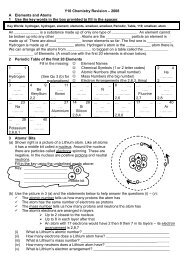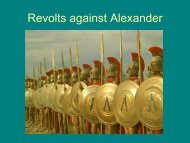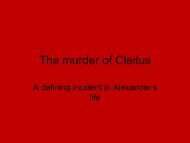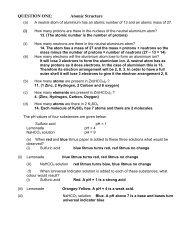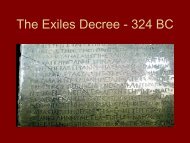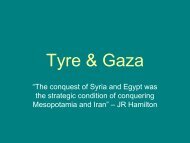Atomic structure
Atomic structure
Atomic structure
You also want an ePaper? Increase the reach of your titles
YUMPU automatically turns print PDFs into web optimized ePapers that Google loves.
Mixtures – two or more substances that are notchemically combined with each other and can beseparated by physical means.Elements – simplest form of pure substance. Theycannot be broken into anything else by physical orchemical means.Compounds – pure substances that are the unions oftwo or more elements. They can be broken into simplersubstances by chemical means.Decide whether each of these substances is an element, a compound or a mixture.1 salt crystals Compound 6 helium (in a balloon) Element2 FeSO 4.7H 2O(s) Compound 7 steel3 aluminium foil Element8 ice Compound4 HNO 3(aq) Mixture9 CH 3COOH(l) Compound5 sodium carbonate solution Mixture10 Br (l)MixtureElement
Revision
HISTORY OF THE ATOM460 BC Democritus develops the idea of atomshe pounded up materials in his pestle andmortar until he had reduced them to smallerand smaller particles which he calledATOMA(greek for indivisible)
HISTORY OF THE ATOM1808 John Daltonsuggested that all matter was made up oftiny spheres that were able to bounce aroundwith perfect elasticity and called themATOMS
HISTORY OF THE ATOM1898 Joseph John Thompsonfound that atoms could sometimes eject a farsmaller negative particle which he called anELECTRON
HISTORY OF THE ATOM1904Thompson develops the idea that an atom was made up ofelectrons scattered unevenly within an elastic sphere surroundedby a soup of positive charge to balance the electron's chargelike plums surrounded by pudding.PLUM PUDDINGMODEL
HISTORY OF THE ATOM1910 Ernest Rutherfordoversaw Geiger and Marsden carrying out hisfamous experiment.they fired Helium nuclei at a piece of gold foilwhich was only a few atoms thick.they found that although most of thempassed through. About 1 in 10,000 hit
HISTORY OF THE ATOMhelium nucleigold foilhelium nucleiThey found that while most of the helium nuclei passedthrough the foil, a small number were deflected and, to theirsurprise, some helium nuclei bounced straight back.
HISTORY OF THE ATOMRutherford’s new evidence allowed him to propose a moredetailed model with a central nucleus.He suggested that the positive charge was all in a centralnucleus. With this holding the electrons in place by electricalattractionHowever, this was not the end of the story.
HISTORY OF THE ATOM1913 Niels Bohrstudied under Rutherford at the VictoriaUniversity in Manchester.Bohr refined Rutherford's idea by addingthat the electrons were in orbits. Ratherlike planets orbiting the sun. With eachorbit only able to contain a set number ofelectrons.
Bohr’s Atomelectrons in orbitsnucleus
HELIUM ATOMprotonShell-+NN+-electronneutronWhat do these particles consist of?
ATOMIC STRUCTUREParticleChargeMassLocationproton+ ve charge1NucleusneutronNo charge1Nucleuselectron-ve chargenilAroundoutside
ATOMIC STRUCTUREHe 2 4<strong>Atomic</strong> numberthe number of protons in an atom<strong>Atomic</strong> massthe number of protons andneutrons in an atomnumber of electrons = number of protons
ATOMIC STRUCTUREElectrons are arranged in Energy Levels orShells around the nucleus of an atom.• first shell a maximum of 2 electrons• second shell a maximum of 8 electrons• third shell a maximum of 8 electrons
ATOMIC STRUCTUREThere are two ways to represent the atomic<strong>structure</strong> of an element or compound;1. Electronic Configuration2. Dot & Cross Diagrams
ELECTRONIC CONFIGURATIONWith electronic configuration elements are representednumerically by the number of electrons in their shellsand number of shells. For example;Nitrogenconfiguration = 2 , 52 in 1 st shell5 in 2 nd shell2 + 5 = 7N714
ELECTRONIC CONFIGURATIONWrite the electronic configuration for the followingelements;Ca20Naa) b) c)4011232,8,8,2 2,8,1O8162,6Cl1735Sid) e) f)14285B 112,8,7 2,8,4 2,3
DOT & CROSS DIAGRAMSWith Dot & Cross diagrams elements and compoundsare represented by Dots or Crosses to show electrons,and circles to show the shells. For example;XNitrogen X X N XX XXN 714
DOT & CROSS DIAGRAMSDraw the Dot & Cross diagrams for the followingelements;X8 17a) Ob) Cl XX16 35XXX XXXX X X Cl X XX O XX XXX XX XXXX
SUMMARY1. The <strong>Atomic</strong> Number of an atom = number ofprotons in the nucleus.2. The <strong>Atomic</strong> Mass of an atom = number ofProtons + Neutrons in the nucleus.3. The number of Protons = Number of Electrons.4. Electrons orbit the nucleus in shells.5. Each shell can only carry a set number of electrons.
1. An atom’s electron arrangement is also known as its electron ___.2. A __ is composed of two or more atoms, joined together by covalentbonds.3. Almost all the volume occupied by an atom is ___ space.4. The total number of protons and neutrons in an atom is known as its___ number.5. At the centre of an atom is a very ___, very dense, positively-chargednucleus.6. The particle with no charge inside atoms is called the ___.7. The positively-charged particles inside atoms are called ___.8. Ions with a positive charge have ___ electrons.9. Positively-charged ___ particles were used to discover the <strong>structure</strong>of the atom.10. To calculate the number of neutrons, ___ atomic number from massnumber.
1 configuration 6 neutron2 molecule 7 protons3 empty 8 lost4 mass 9 alpha5 small 10 subtract


